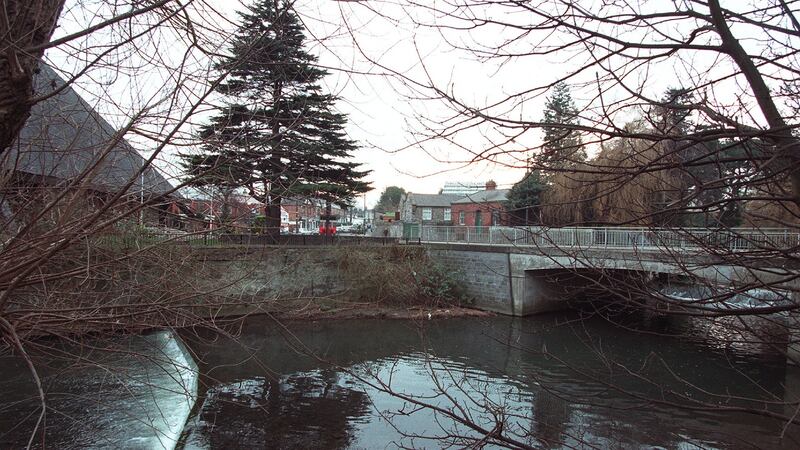For those disheartened about the level of rubbish on Irish city and town streets, at least you didn’t have to deal with the Drumcondra mud heaps of the 1870s, which were a massive source of annoyance to readers and journalists alike.
On May 12th, 1875, a journalist painted a beautiful picture of a part of the city that has changed considerably since then. “One of the most pleasant suburban walks on the northside of the city,” the journalist wrote, “stretches from Drumcondra Bridge by the margin of the river Tolka, through the Bishop’s fields, whence Dublin is supplied with milk from rich pastures, up to the ancient bridge of Glasnevin, where in the expanded pool the trout never cease springing, and many fall victims to the moth thrown by the dexterous angler.”
This pathway was called Lover’s Walk, where the writer informed us the Tolka “flows pure and limpid, forming little lakes, where giant perch pursue glittering minnows and transparent loach. There are herbs and flowers to be found along these pools which you will not find elsewhere, and the gently flowing streams rippled around your hand as you pull the crisp cresses from the edge.”

That’s where the fairytale scene ended. Unfortunately, the Corporation system of cleaning Dublin streets at that time involved sweeping mud from the road into “long ridges”. When it rained, the mud turned into a 10-inch quagmire. This, combined with the open sewers “full of all manner of abomination and exhaling mephitic odours”, also provided a trap for “many a luckless wayfarer, returning to the city after dining with a country friend”.
Less than a year later, February 22nd, 1876, a journalist (probably the same one, going by the style of writing) heralded a victory in the newspaper: “The venerable mud heaps on the Drumcondra and Clonliffe roads are at last to be removed,” the article began, before descending gleefully into some excellent sarcasm.
“Aged men who have looked upon them from childhood and seen them gradually accumulating until some rose to a height of 20 feet, will miss their old acquaintances. Drumcondra Road will no longer be the road they knew and loved. It will now be sweet and clean and airy, and the drainage from the mud embankments will no longer rot the stones shovelled into the ruts.
“Worse still, there is to be a good sound pathway neatly curbed with stone. This is a dreadful innovation, for there were some who found amusement in witnessing the floundering of ladies over the broken pathway in rainy weather, and laughed because of the quantity of slush they carried home on their shoes, stockings and costly garments. All this is to be changed, and changed at once.”
This article was preceded by a letter to the editor, on February 19th, 1876, when a northside reader, R W H Nash, bemoaned “the greatest possible eyesore and disfigurement to this neighbourhood . . . the hideous and unsightly mud heaps that extend along our roads and form an embankment four or five feet in height”.
If Drumcondra were but half as well looked after as are other neighbourhoods not nearly so much favoured by nature, this 'Italy of Ireland' would rapidly increase in prosperity
The reader was, of course, talking about muddy Drumcondra, a suburb so pretty (mud aside) that they viewed it with a continental lens, “I may add, that if Drumcondra were but half as well looked after as are other neighbourhoods not nearly so much favoured by nature, this ‘Italy of Ireland’ would rapidly increase in prosperity,” the reader wrote, remarkably predicting the Drumcondra Mafia a full century before its emergence.
And so the mud was apparently dealt with. But such was the extent of Dublin mud in the 1800s, throughout the city centre and stretching to suburbs north and south, it was a mainstay in local conversation at the time. Three years later, the subject of Dub mud returned, almost wearily, to the pages. On March 24th, 1879, a journalist wrote, “We did not think there was anything new to be said on the subject of Dublin mud; but it seems the weather to be an inexhaustible topic.” Some things never change.
The reporter called again on the Corporation to get to it and clean the streets. “It takes a strong horse to draw a load of coal through the deep ruts and mud heaps,” a despairing reader wrote to the newspaper about Rathmines in January of 1900.
Today, Drumcondra is undergoing another renovation. The new owners of the The Big Tree – situated where the Royal Canal divides Dorset Street and Drumcondra Road – are planning to build a hotel on the site, and are now seeking permission for the partial demolition of the legendary 1830s pub.
Back in 1876, where the Big Tree house had already been in situ for four decades, The Irish Times looked forward to the mud clearing, “So in the summer time, as we did a long time ago, we can walk from the site of the Big Tree until we reach the murmuring Tolka and see the trout rising at the moths on summer evenings.”










